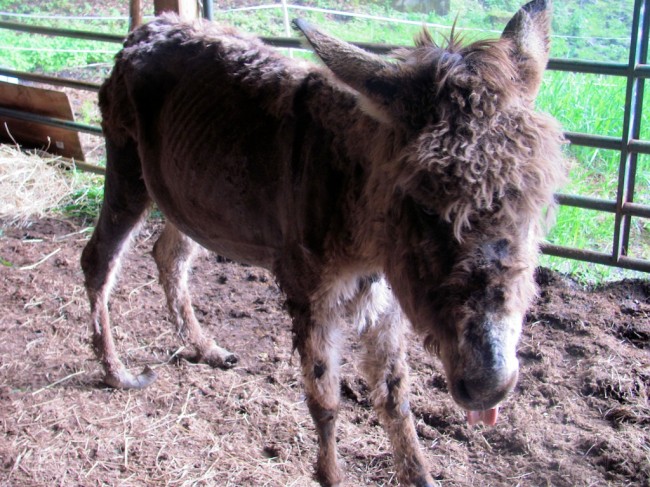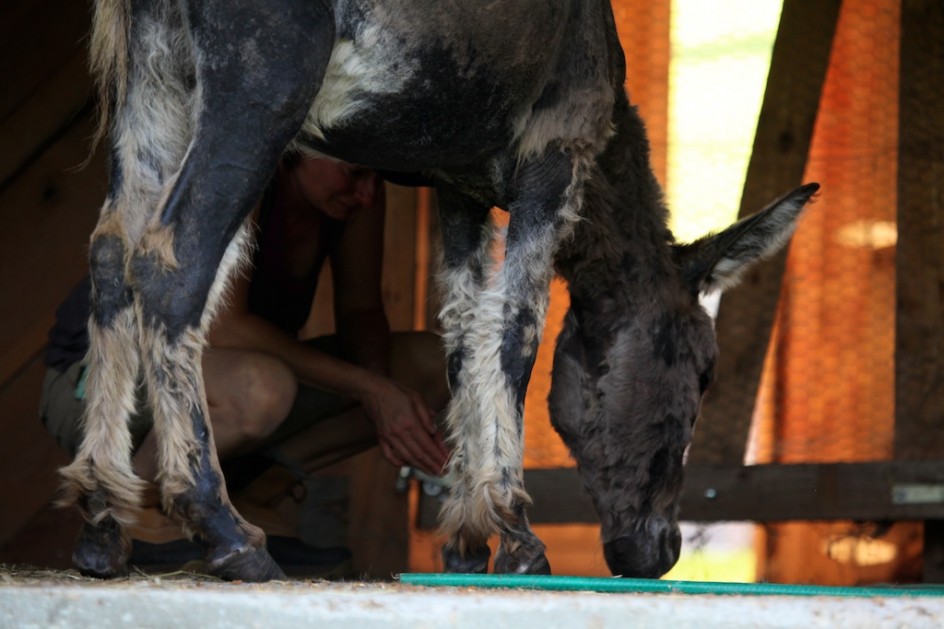
I have an itch to borrow a neighbor’s cow trailer and take Simon down to New York City to show the people there what cruelty to animals really means. Perhaps we could rent a stall in the stables on 52nd street where some of the horses are kept, Simon would be happy there, it is heated, there are other equines around for him to hang out with, there is fresh hay and grain and he could charm the visitors there into giving him some cookies and carrots. Simon would love it in those tables I think, it would definitely be an upgrade from the Pole Barn where he and the sheep go to get out of the snow.
He would love working in Central Park even more, he loves to wear his red hat, plod along on streets and paths. He is a working animal, a guard donkey, he is also a charmer, he’ll do almost anything to get treats and attention, do any kind of work with people, especially if there are children around. He would be a star witness at any hearing involving animal cruelty, he might even shame the people who proclaim so loudly that they are for animal rights into thinking about what they actually mean.
Simon reminds me every day that it is important for animal lovers and animals welfare to stop and consider what cruelty to animals really means. Words are cheap and easy to throw around, especially to modern journalists, increasingly little more than stenographers recording endless arguments. Melissa Mark-Viverito, the new City Council President said of the Central Park Carriage Horses recently that “it’s long past time we end these practices which treat the horses so cruelly.” Edita Birnkrant, the New York director Friends of Animals, likened the horses’ working conditions to prison in an interview with the New York Times. ‘They are shackled into their carriages, pulling through streets of a chaotic unnatural environment and go back to their cells,” she said. “They need the ability to graze and roam freely. They never get that in New York. They live a life of total confinement, day after day.”
Cruelty to animals is a serious crime, in New York City and almost everywhere else in America. The American Legal Dictionary defines cruelty to animals in this way: “the crime of inflicting physical pain, suffering or death on an animal, usually a tame one, beyond necessity for normal discipline. It can include neglect that is so monstrous (withholding food and water) that the animal has suffered, died or been put in imminent danger of death.” Animal abuse is defined as the “willful or deliberate infliction and suffering or harm upon animals.” It would seem that many of the carriage owners and drivers would be in jail for inflicting so much cruelty on their horses, since so many people in New York are concerned about it, but none of them are. No one seems able to explain that.
While many sometimes cynical New Yorkers seem to believe real estate underlies the efforts to drive the carriage horses out of their stables, the Mayor and leaders of the groups that call themselves animal rights organizations repeatedly cite cruelty. They consider the animals very work and existence in the city abusive. The nature of modern New York is incompatible with animals like these horses, although they do not explain why it is natural to have countless thousands of dogs and cats (and people) on those same streets.
I wince a bit when the word “cruel” is applied to the carriage horses of Central Park, they are fed, watered, sheltered and monitored every day of their lives, protected from extremes of weather, they are sturdy, calm, healthy-looking and without any bruising , skittishness, shyness or any of the legal manifestations of abuse or neglect.
I should admit that this is a somewhat personal to me because I am writing a book about Simon, the donkey pictured above on the morning after the New York State Police took him off of a farm in upstate New York, charged the farmer with neglect and brought him to me. Simon reminds us not to trivialize the real meaning of animal cruelty, otherwise it will lost all of it’s meaning, as is happening to the idea of animal abuse.
Simon was in great physical pain when the police raided his farm. He had been lying on his side so long starving and weak in the freezing cold that his hide was black – rain rot – and many of his teeth had grown into his jaw and had to be removed. He was covered with lice, sores, infections, he was nearly blind from pus and discharge in his eyes.. He had been denied food and water for weeks, even months, existing on bits of grass and bark, rain water and melted snow, he was emaciated, he had suffered neglect so monstrous that he had suffered greatly, and was, said the vet and farrier who examined him, in danger of imminent death.
He was the victim of animal cruelty.
In my life with animals, I have never witnessed anything as disturbing as the sight of Simon, it transformed me, I happy took him in, my wife and I tended carefully to his wounds, fed him soft food until his jaws healed, applied balms to his rotted skin, treated his hooves, which had grown out six to eight inches on either side of his ankles, they had not been trimmed in years, treated his eyes, his many sounds, watched hopefully as his ribs receded. At night, I read him donkey stories from “Platero and I,” “Don Quixote.” He loved them then, he loves them still. Simon is well now, content and affectionate, his legs are still twisted and weak, but he seems otherwise recovered, he was so close to death, his rescuers considered putting him down as an act of mercy.
When the politicians and animal rights activists in New York accuse the Carriage owners and handlers of cruelty, I have to mistrust their grasp on the reality of animal life, as I have seen or heard nothing in any of the long string of accusations and condemnations of the people who own these horses that would square in any way with my understanding of cruelty to animals. Giving working horses work, exercise, health care, fresh food and water and shelter from the elements does not fit any definition of cruelty and abuse I am aware of or have seen, even if it isn’t a good idea. It is cruel in itself to accuse people with animals of this kind of crime, it is more hurtful than throwing rocks, you cannot, I believe, love animals if you treat people cruelly. Does it seem strange to say that the people who own and ride these horses are human beings, I see from reading their statements many are deeply hurt by the accusations against them.
I would be very surprised of some horses were not neglected or mistreated, just as so many dogs, cats and human children and adults are, we humans are capable of a wanton cruelty few animals could even imagine, as rough as the natural world can be. Animals do not have perfect lives, any more than people do.
But their stalls are too small, one woman complained on my Facebook page. Build bigger stalls, I said. But one of the drivers was recently arrested for neglected to treat a horse’s foot infection. Fire him and fine him, I said. But the horses should be free to roam freely and eat green grass, said another. That is not the life of a working horse, I said, there are no such places in most of America, life in the wild without people is crueller for a working animal than anything that might happen in Central Park. But the streets are not safe, they are filled with trucks, said another. Do for them, I said, what the city does for bicycles, ban trucks from some roads and provide the horses safe lanes of passage.
Here’s a thought, I wrote, make their lives better, show the world that animals can live with people and be safe and healthy, that they are important to us. If they are banished, as seems likely, they will disappear from the urban consciousness, no one in New York will have a stake in their welfare or continued existence on our planet. No species of animal can survive only as a rescued creature, hidden away in animal ghettoes, a fixture only on wealthy farms and isolated and usually impoverished rescue preserves.
Simon haunts me, his gentle spirit whispers in my ear. I will never get over the sight of him, or his struggle to live for so many months, his superating wounds, diarrhea, choking, torn-up mouth, his infected eyes, the agonized pain of eating, chewing and standing, the flies and maggots working at his many sores and wounds. It is profoundly offensive to the very real suffering of so many animals to compare his experience with the lives of the carriage horses.
If the people of the city of New York, their Mayor and City Council President, the many loud and insistent groups howling for th removal of these horses all wish that they be banned, it is not for me to tell them otherwise, democracy is not often pretty, it is a system I believe in. I don’t live in New York City. They cannot perhaps realize they are not advancing the rights of animals, rather they are writing yet another tragic and sorry chapter in the destruction of animals in our world, and so often in the guise of self-righteousness and “rights.” Here, the right to perish and lose a life of human connection, meaning and purpose. Grazing is not the entire rationale for any animal’s existence. It would seem more honorable to me if the forces pushing this course could perhaps be clear and direct in their motives, and more decent in their statements. I don’t recall that mobs ever serve much of a purpose, other than to sweep things away.
I love Simon, I have become one of those crazy men who talks to his donkey, walks with him through the theater of chance, as donkeys have. I believe Simon is a witness to the true meaning of cruelty to animals, he would have dearly loved the life of a Central Park Carriage horse, he would love it still, he loves to work, to be with people, to be around children, to soak up every bit of the mystery of working with human beings, perhaps the most glorious and successful – if never perfect – chapter in the annals of earthly species. I wish I could bring him to New York to testify, to meet the Mayor, to tell the City Council President what cruelty really means, to show what it is to love an animal rather than push them away.

